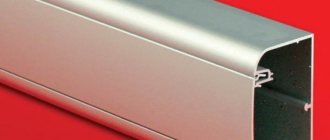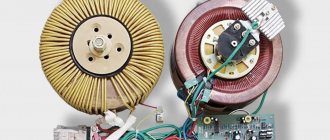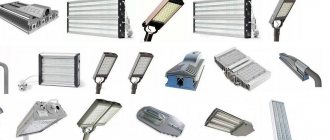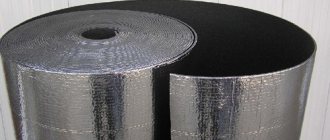No. 1. Basic selection options
A cable channel is a special hollow structure with space for electrical wires. The product consists of a tray, which is installed on the surface of a wall, floor or ceiling, and a lid. There are boxes with a slightly different design, but this is the most common. Cable channels can also be used to lay telephone, Internet and television lines; they are often used to disguise air conditioner wires. In large offices, where it is necessary to provide each workplace with electricity, the Internet and a telephone line, cable channels are completely irreplaceable.
When it is not possible to hide wiring in the wall, a cable channel is a real salvation. The main advantages of such a solution are:
- protection of wiring from ultraviolet radiation and mechanical influences;
- increasing the fire safety of the premises, although many are ready to dispute this point, because the cable channel is a closed space, and the wires certainly heat up, i.e. the heat remains inside the structure, which means the risk of ignition is much higher than when laying the wire without protection. But it is also worth considering the fact that the cable channel is a sealed structure, there is almost no oxygen supply, so the fire will not be able to spread, and the ignition will go out. In addition, there are perforated channels, which, due to the influx of fresh air, cool heated cables;
- the ability to instantly replace the wire or lay a new branch. If the cable is in the wall, then any manipulation will lead to serious damage;
- the ability to lay several wires in one channel, incl. different types, such as wiring and telephone lines. For these purposes, there are special designs with internal partitions;
- quick installation of electrical wiring.
as a disadvantage , since a plastic channel running along the wall is unlikely to decorate the room, but everything is learned by comparison. A neat cable channel is clearly much better than a hanging bundle of wires. If we take into account the presence of numerous modifications of the channels, the wiring can be made almost invisible. There are products that are indistinguishable from ceiling or floor plinths, there are models painted to look like wood - there are a lot of options, however, such solutions with increased aesthetics are more expensive than the simplest products made of white plastic.
The disadvantages include the fact that the cable takes up a little space. Yes, often such a loss does not bring any inconvenience, but there are times when every centimeter counts. In addition, high-quality wiring using cable channels is only possible when using a large number of auxiliary elements, i.e. In addition to the channel itself, tees, corners, etc. will be needed. Please also take into account the fact that a protruding element on a wall or floor can easily get caught and damaged.
When choosing a cable channel for electrical wiring, consider the following factors:
- material of execution , which affects the level of durability, strength and fire resistance;
- design features . The cable channel can have a rectangular, angular or semicircular cross-section, it can be flexible or lattice - there are a lot of variations, each will be indispensable in a given situation, and we will consider each type further;
- features of the room where the wiring is being laid. For example, a channel for a wooden house must meet increased fire safety requirements, but for moving structures it is unacceptable to use stationary cable channels;
- appearance . Aesthetics are important for residential premises, so the color and shape of the cable play an important role;
- size . The more wires you need to hide, and the larger their cross-section, the larger the cable channel will be needed, but we will return to this later.
Our catalog
The online store 220.ru offers at a reasonable cost different types (types) of plastic electrical boxes in size, color, etc. The cost of the product can be seen in the price list: there is a photo and the price per meter is indicated. Here you can choose electrical boxes:
- for external (street) or internal wiring;
- wall or floor electrical installation.
To buy a product, fill out an application on the website. We sell electrical products in Moscow and other regions of the Russian Federation from trusted companies. We accept payment in cash and by bank transfer.
We also accept calls from customers to tell us about discounts and promotions. You can ask the operators on duty about the time frame for receiving the goods.
No. 2. Cable channel material
The most popular channels are plastic ones; metal ones are less commonly used. There are also ceramic cable ducts , but they are expensive and not very practical, so they are used quite rarely.
Plastic cable channel for electrical wiring
Due to their low cost and ease of installation, plastic channels have gained the greatest popularity. The products are made from PVC with the addition of special substances that increase the material's resistance to sunlight, fire and aggressive chemicals. As a rule, the channels have a U-shaped cross-section, but they can be triangular, in the form of a hemisphere, and also W-shaped, when there are partitions inside for several types of cables. Used for laying low-current and power lines in residential premises, offices and enterprises.
Advantages:
- low price;
- minimum weight;
- operation is possible in a wide temperature range, from -320C to +900C;
- fairly simple installation due to a simple fastening system and low weight;
- corrosion resistance;
- enough variety. Channels are available in various shapes and colors; you can choose a product that will be as similar as possible to a regular floor plinth and made to look like wood;
- the structure will require minimal maintenance;
- the material is easy to cut.
The plastic cable channel cover is installed as simply as possible - no additional tools are needed. The standard length of one section of a plastic channel is 2 m, width and height range from 10 to 60 cm, but other options may occur.
The plastic cable channel can be attached to the surface using self-tapping screws, metal staples or dowel nails. Permanent fastening involves gluing the channel to the wall, but it is also important to take into account the weight of the product. To make it possible to hide wiring of any complexity, in addition to straight channels, additional elements are produced, such as tees, corners and plugs. There are even separate elements for sockets and switches.
Despite their fairly high fire resistance and self-extinguishing ability, plastic cable ducts are not recommended for use in areas with increased fire hazard.
Metal cable channel for electrical wiring
Metal products can withstand increased loads, which is why they are used primarily in enterprises and not in residential premises. They are used for internal and external cable routing. The products are great when you need to hide an impressive bundle of wires.
Metal cable channels are made from:
- galvanized steel;
- anodized aluminum.
galvanized steel box has high mechanical and corrosion resistance and becomes protection against electromagnetic rays, therefore it is often used for laying cables for video surveillance and warning systems.
An anodized aluminum box also becomes a good barrier to electromagnetic rays; it is resistant to fire, mechanical stress, durable, and is not afraid of sunlight.
The metal cable, as a rule, is U-shaped and can be solid or perforated. If the base is flammable, then a solid channel must be used. Separately, it is worth highlighting the staircase channels - they are used only in production conditions. The channels are secured to the base with dowels, anchors or bolts.
The main advantages of metal cable channels :
- fire resistance;
- high strength, allowing to withstand the weight of a whole bundle of power cables;
- durability and resistance to mechanical damage;
- protection against electromagnetic radiation, which is important for communication cables.
Among the disadvantages , we note that installation is more complex compared to a plastic channel: since the weight of the metal is greater, the installation process also becomes more complicated, but this work still cannot be called particularly difficult. Thanks to the presence of a lid with a latch, assembly is carried out in a fairly short time. Complex systems are assembled using T- and X-shaped parts, as well as angles of different configurations.
No. 3. Types of cable channels by design
There are a huge variety of different cable channels, and in many selection guides all types are listed en masse. To make it more convenient, we suggest first dividing all product options by type of design, and then by installation features.
Based on the type of design, the existing range of cable channels can be divided into the following types:
- smooth, with a solid body without holes, is a fairly popular option. Material of manufacture: plastic or metal. Ideal for mounting on walls and ceilings. Since the structure is sealed, there must be enough free space inside so that the wires do not heat themselves and cause a fire;
- perforated cable channels They weigh less and are cheaper, but these are not their main advantages. The holes provide effective ventilation so that the risk of cable overheating is minimized. Additional convenience - the teeth in some places can be broken off and a sufficient hole can be obtained to lead the wire to a socket or switch, which is very convenient. The downside is its low aesthetics: such a channel does not completely hide the wiring, so it is rarely used in residential premises. If the wall material burns easily, it is better to use a smooth channel;
- flexible cable channels - an alternative to more familiar rigid products. The latter are well suited if the surface has the correct geometry. If there are many non-standard architectural elements in the room, or there are rounded surfaces, then it is better to use flexible cable channels. They are several types: tubular, rubber and flexible chains (so-called tracks). Another option is smooth tubes made of soft plastic. Rubber and plastic channels protect the cable well from any damage, so they can be used even in rooms with high humidity, with the exception of baths and saunas. Tubular channels are made of metal twisted into a spiral. Such products can bend in different directions. Flexible chains typically bend in one plane and can be made of metal or plastic. Often, tracks are used in industrial settings to connect equipment. Cable tracks can be closed or open. The former are used when the cable needs protection from moisture, dust and other negative environmental influences. If there is no source of dangerous influence on the wire at the installation site, then you can use an open-type flexible track - it is cheaper and lighter. Separately, we note the flexible channel with the function of three-dimensional circular rotation; individual elements, if necessary, can be removed from it or, conversely, added. These are quite expensive products that have so far found application in the creation of robotic mechanisms. However, even the most common flexible channels are more expensive than similar rigid options, so they are used only in places with complex surface topography;
- wire channels allow wires to be effectively ventilated and provide the easiest possible access to cables. These are the cheapest cable channels; they are widely used in industrial and warehouse premises;
- staircase channels receive a reinforced structure, are used when laying heavy cables, and are made only of metal. Not used in private construction;
- transparent channels – this is more of a design decision than a constructive one. This is a channel with a triangular cross-section, designed for installation at the junction of floors and walls, ceilings and walls, walls and wall cabinets. The longest side in such channels (the hypotenuse) is made of transparent or translucent plastic. These products are intended either only for installing LED strip lighting, or for simultaneous cable laying and lighting.
Types of metal boxes
The metal box for the wire can be of several types. Moreover, these boxes differ not only in appearance, but also in the structure of the material from which they are made. The differences in the shape of the box and the method of fastening are so wide that they practically defy description.
So:
- For private households, so-called blind or non-perforated boxes are most often used. They have a continuous structure and completely hide communications from prying eyes. At the same time, such boxes require proper installation, as moisture can accumulate in them.
- Perforated boxes do not have this drawback. They can be used in dusty rooms, since their structure does not allow dust to accumulate. But their appearance leaves much to be desired, and therefore they are used much less frequently in private households.
The photo shows a mesh box
- So-called mesh boxes are used for laying cable products. Their price is slightly lower than that of the boxes of the type presented above. At the same time, such a box provides practically no protection for cables from external influences and serves solely to support them.
- The same function is performed by the so-called staircases . They have sufficient rigidity for laying a large number of power cables. And we are not talking about any kind of protection here. The last two types of boxes are intended primarily for industrial use.
As for materials, the wire box can be made of stainless steel, galvanized metal and hot-dip galvanized steel. Here the choice depends entirely on the operating conditions and the required durability indicators. It is clear that stainless steel boxes are the most expensive, and galvanized boxes are the cheapest.
No. 4. Types of cable channels according to installation features
Wiring, telephone and internet lines can run along walls, ceilings, floors and corners. Each case has its own type of cable channel:
- wall products have a square or rectangular cross-section, sizes vary in a wide range, which allows you to equip systems of any complexity;
- mini cable channels - a variation of wall boxes. The main feature is its minimal dimensions, which allows the product to fit very neatly into the interior. The channel remains almost invisible, especially if you match it to the color of the wall. This product is designed for laying single wires or several thin cables, often used when installing television, telephone and Internet lines. To create various configurations, corners, plugs and tees are used, but these elements are not cheap, and they are rarely found on sale, so craftsmen simply file the channels at the desired angle to create a right angle, which works out well. Attach mini cable channels to self-tapping screws, dowels or adhesive tape. The latter option is especially convenient when laying wires along furniture (for example, under a table);
- floor cable channel differs in cross-section in the shape of a hemisphere. Thanks to this solution, the risk of tripping over the box and getting injured is eliminated. In apartments, this type of channel is not used very often. The products are much more popular in large office spaces such as open space, when it is necessary to provide appropriate conditions for many workplaces in one area. In this case, electricity, Internet, and a telephone line are supplied to the tables in floor ducts. The requirements in terms of strength for such products are increased. It's better to take an aluminum box. Plastic will also work, but not ordinary, but reinforced, with additional partitions that can also be used as a separator between wires for different purposes;
- corner have a cross-section in the form of a right triangle, designed for installation under the ceiling, at the junction of the surface of the wall and the ceiling. In appearance, such a box can easily be confused with the simplest ceiling plinth, so the product cannot harm the aesthetics of the room. Like other cable channels, it consists of a tray and a cover, and the latter can be transparent or opaque. Products with a transparent cover are used for installing LED strips;
- plinth with cable channel – this is the best example of combining business with pleasure. In appearance, the product is no different from a regular floor plinth; it can be of almost any color and shape. The internal cavity is intended for the location of wiring cables, the Internet, cable television, and thanks to the external and internal corners, turns and splitters, a very complex configuration can be created. There are even sockets and socket groups that can be successfully fitted into the floor plinth. If you need to stretch a whole bundle of wires, then this option is unlikely to work, since there must be enough space inside. The main disadvantage of such channels is their high cost, but they allow you to avoid the dirty and complex process of wall slitting;
- parapet cable channels They resemble baseboards, but are installed at a small height from the floor (80-100 cm), they have a symmetrical cross-section and sufficient width. The products have gained wide popularity when laying wiring in offices and various institutions; such channels are not suitable for home interiors, as they will be very noticeable, with the exception of loft-style interiors.
Installation price:
Add.
information ➤ * Installation collections take into account measurements and tests of materials and equipment, as well as commissioning work necessary to prepare equipment for individual tests (Methodology approved 511/pr.).
FERm10-08-001-06
Signal reception and control devices, concentrator: basic unit for 10 beams
342










